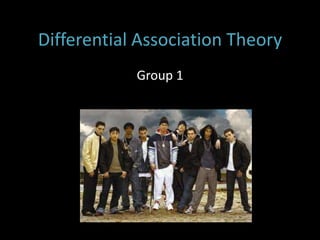
Spa2 power point
- 1. Differential Association Theory Group 1
- 2. What is it? • It is a theory first coined by Edwin H. Sutherland in which values, attitudes, techniques, and motives for criminal behavior is learned mainly through intimate groups and process of communication. • Example: friends, peers, family, work, sports, gangs
- 3. The Nine Principles of the Differential Association Theory • 1. Criminal behavior is learned. • 2. Criminal behavior is learned in interaction with other persons in a process of communication. • 3. The principal part of the learning of criminal behavior occurs within intimate personal groups. • 4. When criminal behavior is learned, the learning includes (a) techniques of committing the crime, which are sometimes very simple; (b) the specific direction of motives, drives, rationalizations, and attitudes. • 5. The specific direction of the motives and drives is learned from definitions of the legal codes as favorable or unfavorable. • 6. A person becomes delinquent because of an excess of definitions favorable to violation of law over definitions unfavorable to violation of law. • 7. Differential association may vary in frequency, duration, priority, and intensity. • 8. The process of learning criminal behavior by association with criminal and anti-criminal patterns involves all of the mechanisms that are involved in any other learning. • 9. While criminal behavior is an expression of general needs and values, it is not explained by those general needs and values since non-criminal behavior is an expression of the same needs and values
- 4. According to the theory… • Kids become involved in more frequent or serious behavior by: -Socially mingling in a network of close-knit relationships that maintain the importance of the relationship. -Learning criminal behavior from the trusted network of peers because expectations are established (Haynie, 2002). -Those expectations of criminal behavior has now become “normal behavior” for the delinquents Example: Gang Involvement
- 5. Remember !!!! **Due to the fact that peer friendships are very important during the adolescent years, acceptance by peers is crucial **These types of close networks (i.e. gang) are very influential to a juvenile’s criminal behavior (Haynie, 2002). “Monkey See, Monkey Do”
- 6. According to the theory.. WHY do kids continue to act in such delinquent ways? -Kids may feel secure with their delinquent group because it offers rewards in the form of satisfaction of noncriminal desires such as the desire for companionship (i.e., friends or family) - In certain groups, such as gangs, kids may provided stimuli to encourage security and protection from “rival gangs” (Kissner and Pyrooz, 2009).
- 7. With This Theory in Mind… • How can kids change their criminal behavior? • Since the influence of a certain group will greatly affect the individual… • Involvement in a nicer, wholesome, and brighter group of peers, family, or friends could change the kid’s behavior to positive attitudes by learning from them! •
- 8. Probation Officer’s Guide to High Risk Youth
- 9. Family Dynamics • Absent Parents • Parents with criminal history • Siblings with criminal history • Violence in the home • Parents/siblings gang involvement
- 10. Past Criminal History Numerous probation violations Not affected by breaking the law as it is favorable Breaking the law as part of a gang. Long and extensive history of law violations
- 11. Juvenile’s Mindset • Positive attitude toward crime • Unwillingness to change • No remorse over crime • Negative goals – Ex: be a ranking member in a gang, kill a rival gang member etc…
- 12. 3. How authoritative figures can prevent juvenile delinquency • Become better leaders – As previously stated, juveniles are known to imitate, (“Monkey see, monkey do”), because they do not see the bigger picture. If there were more people in their lives that came from their same struggle but made a way out of it, they will look to their success and attempt achieving similar goals. According to Sutherland, most learning occurs within intimate groups so if authoritative figures (i.e. parents, teachers, etc,.) are present and active in these juveniles lives, they reduce the risk of them engaging in delinquency. i.e. The Big Brother, Big Sister Program
- 13. •Be persistent & be consistent – Set boundaries and make sure they are followed. – Get all surrounding adults on the same page so the juvenile understands that if they can’t get away with something from their parent, they can’t from their teacher either.
- 14. • Keep them busy!! • Sports and extra-curricular activities are a great way to keep a child out of trouble. Sports are known to keep them focused and disciplined. So just as a criminal behavior can be learned (Principle 1), good behaviors can be learned as well. (i.e. teamwork & accountability)
- 15. • Stop trying to be their friend… • Parents who try to be more of a friend to their child than and parent often do more damage than healing. It is almost as if they are blind sided as to what their role is. • Juveniles need direction and firmness. This should come from someone who is less interested in trying to become their friend and trying to help guide them on a positive path.
- 16. Contributions by Tamika Jones Jiwon An Miguel Ramirez Jasmine Velazquez
Notas do Editor
- Haynie, D. L. (2002). Friendship Networks and Delinquency: The Relative Nature of Peer Delinquency. Journal Of Quantitative Criminology, 18(2), 99-134.
- Haynie, D. L. (2002). Friendship Networks and Delinquency: The Relative Nature of Peer Delinquency. Journal Of Quantitative Criminology, 18(2), 99-134.
- Jason Kissner, David C. Pyrooz, Self-control, differential association, and gang membership: A theoretical and empirical extension of the literature, Journal of Criminal Justice, Volume 37, Issue 5, September–October 2009, Pages 478-487, ISSN 0047-2352, 10.1016/j.jcrimjus.2009.07.008.(http://www.sciencedirect.com/science/article/pii/S0047235209000919)